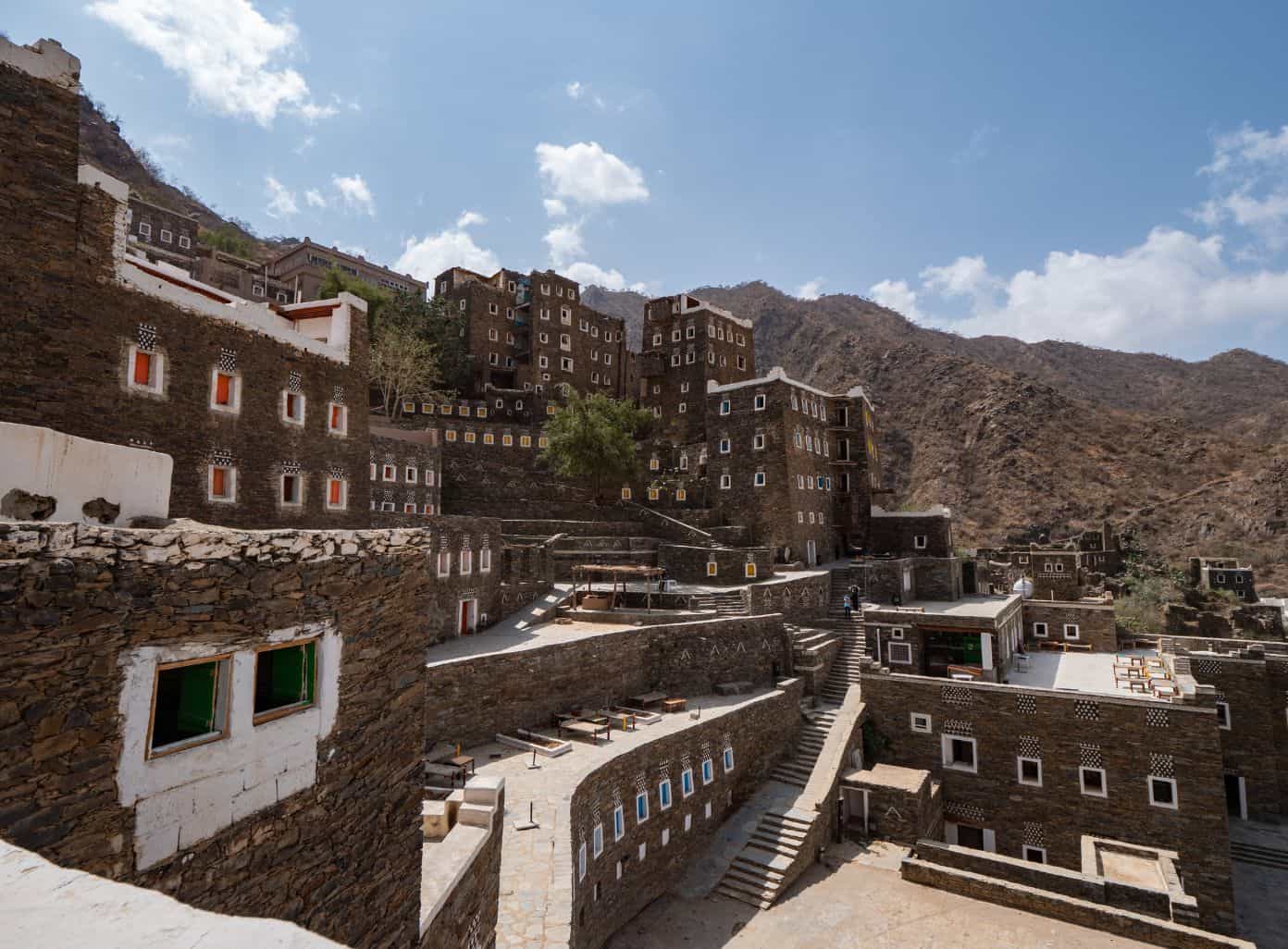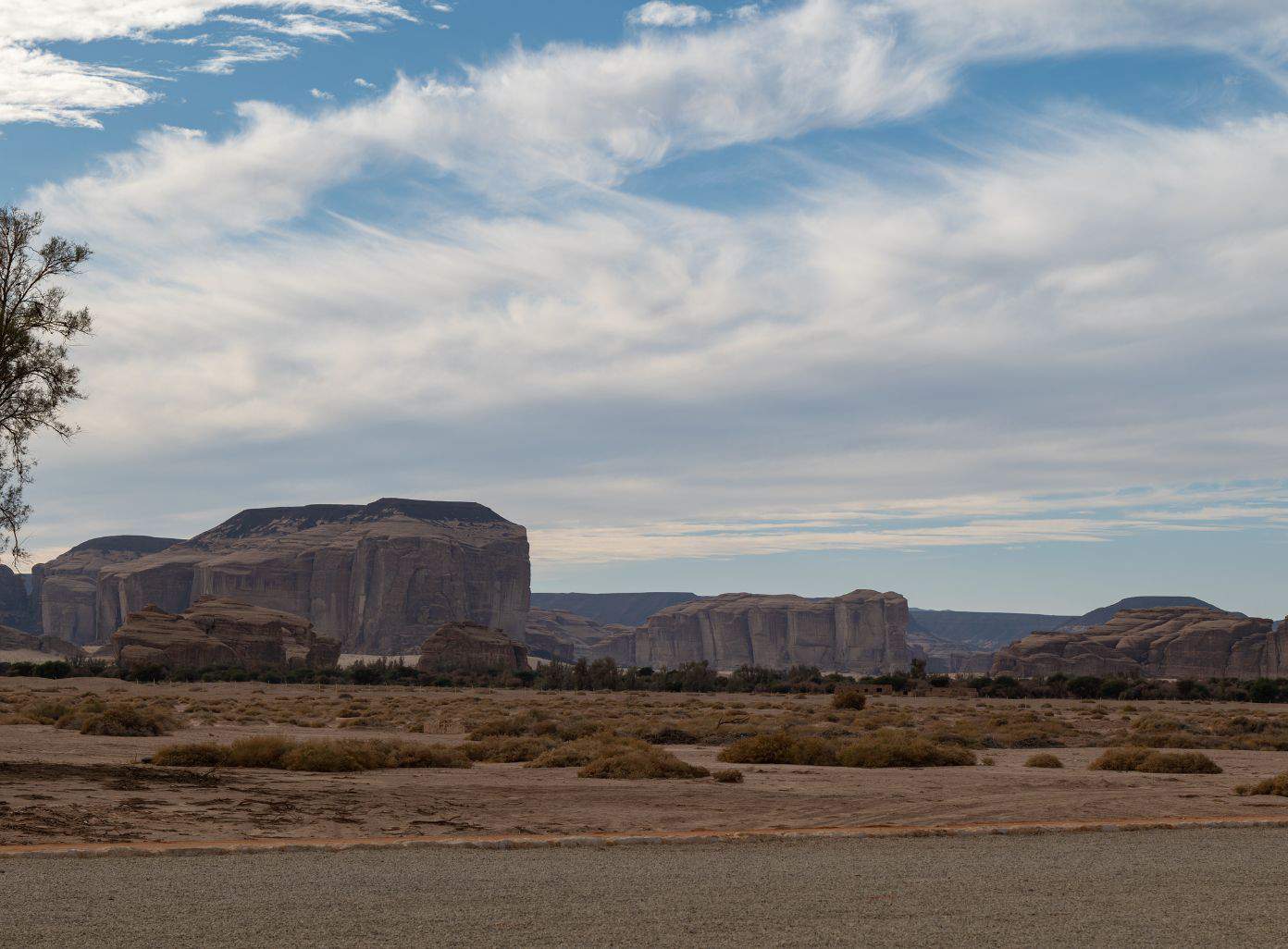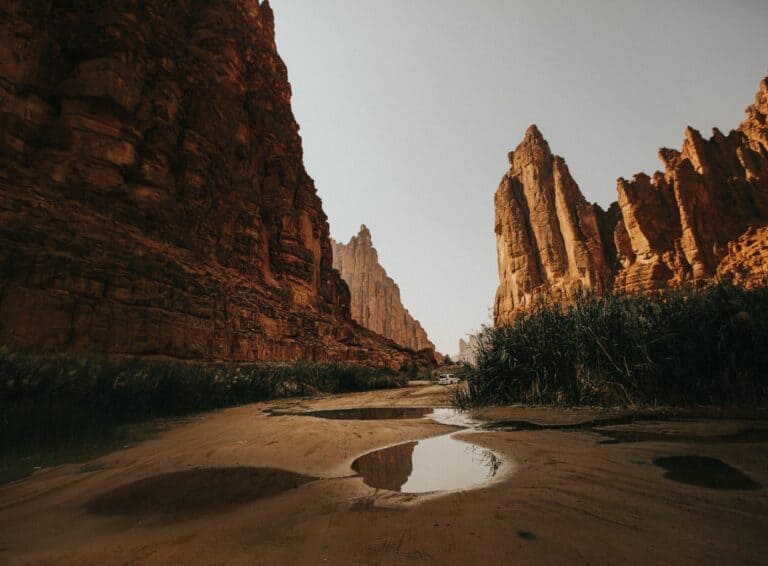Saudi Arabia’s Majestic Mountain Ranges
Saudi Arabia is not only known for its vast deserts and modern cities, but also for its majestic mountain ranges that offer breathtaking natural beauty and historical significance. These mountain ranges have played an important role in the history of Islam and continue to be places of spiritual and cultural significance for Muslims around the world.

Introduction to Saudi Arabia’s Mountain Ranges
Saudi Arabia is home to several mountain ranges, each with its own unique characteristics and allure. These mountain ranges provide a striking contrast to the country’s desert landscapes, offering cool temperatures, lush greenery, and stunning vistas. They are a haven for nature enthusiasts and those seeking a respite from the hustle and bustle of city life.
Importance of Mountain Ranges in Islamic History
The mountain ranges of Saudi Arabia hold great importance in Islamic history. Many significant events in the life of the Prophet Muhammad (peace be upon him) took place in these mountains. For instance, the Cave of Hira in the Asir Mountains is where the Prophet Muhammad (pbuh) received the first revelations of the Quran. This event marked the beginning of the Islamic faith and is a site of profound spiritual significance for Muslims.
The Sarawat Mountains are believed to be the location of the ancient city of Mada’in Salih (Al-Hijr), which is mentioned in the Quran as the dwelling place of the Thamud people. This archaeological site is a UNESCO World Heritage site and showcases the rich history and architectural marvels of the region.
The Hijaz Mountains hold religious significance as they are home to the holy cities of Mecca and Medina, the two most sacred cities in Islam. Muslims from around the world travel to these mountains to perform the Hajj pilgrimage and visit the Prophet’s Mosque in Medina. The rugged beauty of the Hijaz Mountains serves as a backdrop to the spiritual journey of millions of Muslims every year.
By exploring Saudi Arabia’s mountain ranges, Muslims can connect with their faith, immerse themselves in natural beauty, and witness firsthand the historical sites that hold significance in Islamic history.
As you embark on your journey through these majestic mountain ranges, it is important to be well-prepared and informed about the specific locations, cultural etiquette, and safety considerations. In the following sections, we will delve deeper into each mountain range, providing you with valuable insights to help you make the most of your experience.

Exploring the Asir Mountains
Nestled in the southwestern region of Saudi Arabia, the Asir Mountains showcase breathtaking natural beauty and hold significant cultural value. Let’s delve into the location and overview of the Asir Mountains, their cultural significance, and the activities and attractions they offer.
Location and Overview of the Asir Mountains
The Asir Mountains stretch across the Asir Province in Saudi Arabia, forming part of the larger Sarawat Mountain range. This region is characterized by its rugged peaks, deep valleys, and lush greenery, creating a picturesque landscape that attracts visitors from all over the world.
With elevations ranging from approximately 2,000 to 3,000 meters (6,500 to 9,800 feet), the Asir Mountains provide a cool and refreshing escape from the desert heat. The higher altitudes offer cooler temperatures, making it an ideal destination for those seeking respite from the scorching Saudi Arabian climate.
Cultural Significance of the Asir Mountains
The Asir Mountains hold immense cultural significance for the people of Saudi Arabia. The mountainous region is home to several tribes, each with its own unique traditions and customs. The local communities have preserved their rich cultural heritage, including traditional arts, crafts, music, and dances.
One notable aspect of Asir’s cultural heritage is the vibrant and intricate Asiri art. The Asiri people are known for their exceptional skills in painting, embroidery, and pottery. Traditional motifs and patterns are often incorporated into their artwork, showcasing the region’s cultural identity.
Activities and Attractions in the Asir Mountains
The Asir Mountains offer a myriad of activities and attractions for visitors to explore. Here are some highlights:
- Hiking and Trekking: The Asir Mountains provide numerous trails and paths for hiking enthusiasts. Whether you are a novice hiker or an experienced trekker, there are options available for all skill levels. The breathtaking views and untouched landscapes make hiking in the Asir Mountains a truly memorable experience.
- Abha City: Abha, the capital city of the Asir Province, serves as a gateway to the mountains. This vibrant city offers a blend of modern amenities and traditional charm. Visitors can explore the bustling local markets, visit museums, and indulge in traditional Saudi Arabian cuisine.
- Asir National Park: Located in the heart of the Asir Mountains, Asir National Park is a haven for nature lovers. The park boasts diverse flora and fauna, including rare species of birds and plants. Visitors can enjoy picnicking, camping, and wildlife spotting within the park’s boundaries.
- Historical Sites: The Asir Mountains are home to several historical sites that offer a glimpse into the region’s past. The Al-Soudah Park, for example, features ancient rock carvings and inscriptions that provide insights into the area’s history and civilization.
By exploring the Asir Mountains, visitors can immerse themselves in the natural beauty and rich cultural heritage of Saudi Arabia. Whether hiking through scenic trails, appreciating traditional art forms, or experiencing the warm hospitality of the local communities, a journey through the Asir Mountains promises a memorable adventure.
Discovering the Sarawat Mountains
The magnificent Sarawat Mountains in Saudi Arabia offer a breathtaking natural landscape and a rich historical significance. Let’s explore the location and overview of these mountains, their historical significance, and the outdoor activities and natural beauty they offer.
Location and Overview of the Sarawat Mountains
The Sarawat Mountains, also known as the Hejaz Mountains, stretch along the western coast of Saudi Arabia. They span approximately 1,100 kilometers (680 miles), running parallel to the Red Sea. These mountains are an integral part of the Arabian Peninsula’s diverse topography.
The Sarawat Mountains feature rugged peaks, deep valleys, and steep slopes. They are home to a variety of plant and animal species, making them an important biodiversity hotspot in the region. The mountains’ unique geological formations, including canyons and cliffs, add to their appeal.
Historical Significance of the Sarawat Mountains
The Sarawat Mountains hold great historical and cultural significance, particularly for Muslims. These mountains are part of the Hijaz region, which encompasses the holy cities of Mecca and Medina. The mountains played a vital role in the early Islamic history, as Prophet Muhammad and his companions traveled through them during their journeys.
The mountains served as a natural barrier, providing protection and privacy for the Prophet and his followers. They also witnessed significant events such as the Battle of Uhud. Today, the Sarawat Mountains stand as a symbol of Islamic heritage and attract millions of pilgrims from around the world who visit the holy cities of Mecca and Medina.
Outdoor Activities and Natural Beauty in the Sarawat Mountains
The Sarawat Mountains offer a diverse range of outdoor activities and showcase the natural beauty of Saudi Arabia’s western region. Adventure enthusiasts can indulge in hiking, rock climbing, and camping in the mountains. The rugged terrain provides ample opportunities for exploration and adrenaline-pumping experiences.
Nature lovers will be captivated by the stunning landscapes, including lush valleys, cascading waterfalls, and panoramic views of the Red Sea. The mountains are also home to unique flora and fauna, making it an ideal destination for birdwatching and wildlife spotting. The region’s pleasant climate, especially during the winter months, makes it an attractive destination for outdoor activities.
Whether you seek adventure or simply wish to immerse yourself in the tranquility of nature, the Sarawat Mountains have something to offer. The rich Islamic history, coupled with the awe-inspiring landscapes, create a unique experience for visitors.
As you plan your journey to Saudi Arabia’s majestic mountain ranges, make sure to prepare adequately, pack the essential items, and familiarize yourself with the safety considerations and cultural etiquette. For more information on planning your trip, refer to our comprehensive Saudi Arabia travel guide.
Note: The information provided in this section is for general reference purposes only. It is advisable to check with local authorities and tour operators for the most up-to-date information and guidance regarding travel and activities in the Sarawat Mountains.
Journeying through the Hijaz Mountains
When exploring Saudi Arabia’s majestic mountain ranges, one cannot miss the Hijaz Mountains. Located along the western coast of the country, the Hijaz Mountains offer breathtaking natural beauty and hold great religious significance for Muslims around the world.
Location and Overview of the Hijaz Mountains
The Hijaz Mountains span approximately 800 kilometers along the western edge of Saudi Arabia, running parallel to the Red Sea. This mountain range is known for its rugged terrain, towering peaks, and deep valleys. It is home to several prominent cities, including Makkah and Madinah, which are considered holy cities in Islam.
Religious Significance of the Hijaz Mountains
The Hijaz Mountains hold immense importance in Islamic history and culture. Makkah, located in the Hijaz region, is the birthplace of the Prophet Muhammad (peace be upon him) and the site of the Kaaba, the most sacred place in Islam. Muslims from around the world visit Makkah to perform the Hajj pilgrimage, one of the five pillars of Islam. The Hajj involves circumambulating the Kaaba and walking between the hills of Safa and Marwa, which are located within the Hijaz Mountains.
Pilgrimage Sites and Historical Landmarks in the Hijaz Mountains
Apart from the religious significance, the Hijaz Mountains are home to several pilgrimage sites and historical landmarks. Here are a few notable places to visit:
- Jabal Al-Nour: Located near Makkah, Jabal Al-Nour is renowned for the Hira Cave, where the Prophet Muhammad (peace be upon him) received the first revelation of the Quran. Pilgrims often climb this mountain to visit the cave and reflect on this momentous event.
- Mount Uhud: Situated near Madinah, Mount Uhud is of historical significance as it was the site of the Battle of Uhud, an important event in Islamic history. Visitors can explore the mountain and visit the graves of the martyrs who fought in the battle.
- Jannat al-Baqi: Also known as the Garden of Paradise, Jannat al-Baqi is a cemetery located in Madinah. It is the final resting place of numerous companions of the Prophet Muhammad (peace be upon him) and other notable figures from Islamic history. Many Muslims visit this sacred site to pay their respects and offer prayers.
- Quba Mosque: Situated on the outskirts of Madinah, Quba Mosque is the first mosque built in Islamic history. It holds great significance as the Prophet Muhammad (peace be upon him) laid its foundation and offered prayers in this mosque. It is recommended for pilgrims to visit and pray at this mosque upon arriving in Madinah.
Visiting these pilgrimage sites and historical landmarks in the Hijaz Mountains allows Muslims to deepen their connection to Islamic history and spirituality. It is important to approach these sites with reverence and respect.
The Hijaz Mountains offer a unique blend of natural beauty and religious significance. Exploring this mountain range allows Muslims to witness the magnificence of the land where Islam was born and gain a deeper understanding of their faith.
Preparing for Your Mountain Adventure
Before embarking on your mountain adventure in Saudi Arabia, it’s essential to be well-prepared. Here are some essential items to pack, safety considerations and tips, and guidelines for respectful behavior and cultural etiquette.
Essential Items to Pack
When heading to the mountains in Saudi Arabia, it’s important to pack the following essential items:
- Appropriate Clothing: Dress in lightweight, breathable clothing that covers your body modestly, following Islamic guidelines. Layering is recommended to adjust to changing temperatures.
- Comfortable Footwear: Choose sturdy, closed-toe shoes or hiking boots that provide good traction and ankle support. This will ensure stability while navigating the mountainous terrain.
- Sun Protection: Carry a wide-brimmed hat, sunglasses, and sunscreen with a high SPF to protect yourself from the intense sun rays at high altitudes.
- Water and Snacks: Stay hydrated by carrying an ample supply of water. It’s also advisable to pack energy-boosting snacks to keep you fueled during your trek.
- Navigation Tools: Bring a map, compass, or GPS device to help you navigate the trails and stay on the right path. Familiarize yourself with the routes beforehand.
- First Aid Kit: Pack a basic first aid kit that includes bandages, antiseptic ointment, pain relievers, and any necessary personal medications.
- Mobile Phone and Power Bank: Carry a fully charged mobile phone for emergencies. Consider bringing a portable power bank to ensure you have sufficient battery power throughout your journey.
Safety Considerations and Tips
When venturing into the mountains, prioritize your safety with the following considerations and tips:
- Research and Plan: Before embarking on your trip, research the trails, weather conditions, and potential hazards. Plan your itinerary accordingly, and inform someone about your plans and expected return time.
- Check Weather Conditions: Stay updated on the weather forecast and be prepared for sudden changes. Avoid hiking during extreme weather conditions such as heavy rain, fog, or storms.
- Stay on Designated Trails: Stick to established trails and avoid straying off the path. This helps prevent damage to the environment and reduces the risk of accidents.
- Buddy System: Hiking with a companion is recommended for safety reasons. If you plan to hike alone, inform someone about your plans and expected return time.
- Stay Hydrated: Drink plenty of water throughout your journey to prevent dehydration. Remember to drink even if you don’t feel thirsty.
- Be Mindful of Wildlife: Respect the natural habitat and wildlife in the mountains. Do not disturb or feed the animals you encounter.
- Emergency Contact Information: Keep a list of emergency contact numbers, including local authorities and medical facilities, in case of any unforeseen circumstances.
Respectful Behavior and Cultural Etiquette
As you explore the majestic mountain ranges of Saudi Arabia, it’s essential to observe respectful behavior and adhere to cultural etiquette:
- Dress Modestly: Dress modestly and respectfully in accordance with Islamic customs. Women should wear loose-fitting clothing that covers their arms and legs, and men should avoid wearing shorts.
- Respect Local Customs: Be aware of and respect local customs and traditions. Always ask for permission before taking photographs of individuals or religious sites.
- Environmental Stewardship: Maintain the cleanliness of the environment by disposing of waste properly and leaving no trace of your visit. Respect the natural beauty of the mountains and avoid damaging flora and fauna.
- Follow Local Regulations: Observe and follow any rules or regulations implemented for the protection of the mountains and surrounding areas.
By packing the necessary items, prioritizing safety, and respecting the local culture and environment, you can make the most of your mountain adventure in Saudi Arabia while ensuring a memorable and respectful experience.


